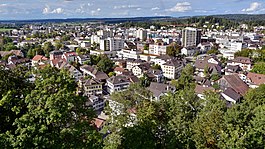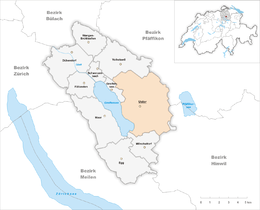Nänikon
| Uster | ||
|---|---|---|
 |
||
|
||
| Coordinates: 47°21′N 8°43′E / 47.350°N 8.717°ECoordinates: 47°21′N 8°43′E / 47.350°N 8.717°E | ||
| Country | Switzerland | |
| Canton | Zurich | |
| District | Uster | |
| Government | ||
| • Executive |
Stadtrat with 7 members |
|
| • Mayor |
Stadtpräsident (list) Martin Bornhauser SPS/PSS (as of February 2014) |
|
| • Parliament |
Gemeinderat with 36 members |
|
| Area | ||
| • Total | 28.53 km2 (11.02 sq mi) | |
| Elevation | 464 m (1,522 ft) | |
| Population (Dec 2016) | ||
| • Total | 34,319 | |
| • Density | 1,200/km2 (3,100/sq mi) | |
| Postal code | 8610 | |
| SFOS number | 0198 | |
| Localities | Kirchuster, Freudwil, Nänikon, Niederuster, Nossikon, Oberuster, Riedikon, Sulzbach, Wermatswil, Werrikon, Winikon-Gschwader | |
| Surrounded by | Fehraltorf, Gossau, Greifensee, Maur, Mönchaltorf, Pfäffikon, Seegräben, Volketswil | |
| Twin towns | Prenzlau (Germany) | |
| Website |
www SFSO statistics |
|
Uster is a city and capital of the district Uster in the Swiss Canton of Zürich.
It is the third largest city in the Canton of Zürich, with over 30,000 inhabitants, and is one of the twenty largest cities in Switzerland. Uster is located next to lake Greifensee.
The official language of Uster is (the Swiss variety of Standard) German, but the main spoken language is the local variant of the Alemannic Swiss German dialect.
The city of Uster received the Wakker Prize in 2001.
The village of Riedikon was first mentioned in year 741, while Uster was first mentioned in 775. In 1099 first mentioned, the donation of the St. Andreas Church was given by the House of Rapperswil as a spacious three-naved country church. The Burg Uster (castle) was first mentioned in 1267, in the possession of the Freiherr von Bonstetten. On 7 January 1300 Elisabeth von Rapperswil sold the pledge of the reign Greifensee to the knight Hermann II. von Landenberg, including the Greifensee castle, the town and the lake of the same name, and a larger number of farms, as well as the pastoral rights (Kirchrecht) in Uster. In 1438 the church rights (Kirchrecht) were sold to the Rüti Abbey. The church was considered as a part of the so-called "Laubishof" estated thath possibly was located at the nearby plateau where the Uster Castle is situated.
During the Old Zürich War, in May 1444, the Old Swiss Confederacy laid siege to the nearby town of Greifensee, held by about 70 defenders, most of them inhabitants of the Amt Greifensee, and a few Habsburg and Zürich soldiers. The town was captured after four weeks, on May 27, and all but two of the surviving 64 defenders were beheaded on the next day, including the leader, Wildhans von Breitenlandenberg. Even in times of war, mass execution was widely considered a cruel and unjust deed. On May 29, the Castle of Greifensee and the city walls were broken.
...
Wikipedia




